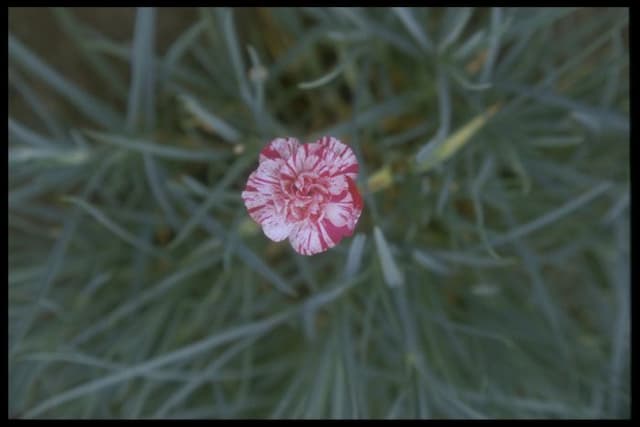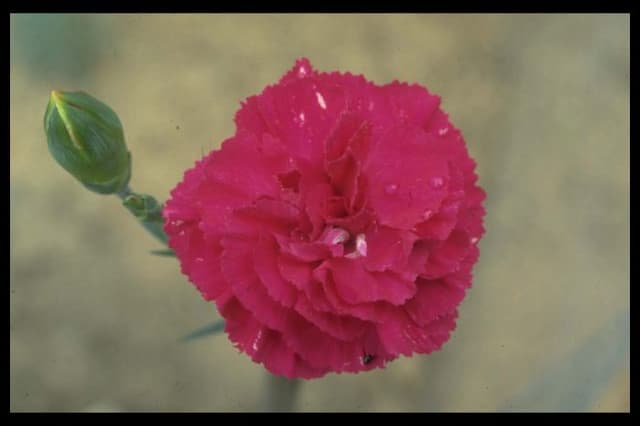Pink Dianthus 'Mendlesham Maid' (p)

ABOUT
Dianthus 'Mendlesham Maid' is a remarkable perennial plant that boasts a wealth of visual charm. The plant displays a dense cluster of blue-green leaves that form a lush, low-growing foliage. The leaves are slender and long, creating a mat-like effect that serves as a beautiful backdrop for the flowers. The blooms of the 'Mendlesham Maid' are particularly eye-catching, featuring a striking combination of pale pink petals with a vivid raspberry eye at the center, providing a delightful contrast against the foliage. Each individual flower bears a distinctive fringed edge, which adds to the textural interest of the bloom. Standing upright on sturdy stems, these flowers exude a delightful fragrance that can be quite noticeable on warm days or in the evening. The plant typically produces a profusion of flowers, which appear in a flush over the course of the flowering season, turning it into a centerpiece of color and fragrance in any garden setting. The overall appearance of Dianthus 'Mendlesham Maid' is one of delicate beauty, with its frilly flowers and contrasting colors drawing the eye and inviting closer inspection.
About this plant
 Names
NamesFamily
Caryophyllaceae.
Synonyms
Maiden Pink, Cheddar Pink, Sweet William.
Common names
Dianthus 'Mendlesham Maid'
 Toxicity
ToxicityTo humans
Carnations, of which Dianthus 'Mendlesham Maid' is a variety, are generally considered non-toxic to humans. Ingestion typically doesn't cause serious harm, but in some cases, people with sensitive skin might experience dermatitis from handling the plant. If ingested in large amounts, there might be mild gastrointestinal discomfort, but serious poisoning is rare.
To pets
For pets, especially cats and dogs, carnations are considered to be mildly toxic. Ingestion can lead to mild gastrointestinal symptoms, including vomiting, diarrhea, and possibly drooling. While it is not expected to cause severe poisoning, it is advisable to keep an eye on pets if they have ingested this plant and consult a veterinarian if symptoms persist or worsen.
 Characteristics
CharacteristicsLife cycle
Perennials
Foliage type
Evergreen
Color of leaves
Green
Flower color
Pink
Height
1 foot 6 inches (45.72 cm)
Spread
1 foot (30.48 cm)
Plant type
Herb
Hardiness zones
5
Native area
Europe
Benefits
 General Benefits
General Benefits- Enhances Garden Aesthetics: Dianthus 'Mendlesham Maid', also known as 'Maid of Mendlesham', features beautiful pinkish-lavender flowers that add color and visual interest to gardens.
- Attracts Pollinators: The blooms of 'Maid of Mendlesham' attract butterflies and bees, promoting pollination in the garden.
- Easy to Grow: This variety is known for being easy to cultivate, tolerant of various soil types, and requiring minimal maintenance.
- Drought Tolerance: Once established, 'Maid of Mendlesham' can tolerate periods of drought, making it suitable for water-wise gardens.
- Long Blooming Period: The plant offers a long flowering season, often from late spring to early fall, providing extended garden interest.
- Edging and Borders: With its compact size and neat growth habit, it is ideal for borders, edging, and garden paths.
- Cut Flowers: The flowers make lovely bouquets and arrangements, holding their color and shape well when cut.
- Fragrant Flowers: The blooms emit a pleasant fragrance, which can add a sensory aspect to garden experiences.
- Versatility: 'Maid of Mendlesham' can be grown in containers, rock gardens, and flowerbeds, offering flexibility in garden design.
- Cold Hardy: It's a hardy plant that can survive through colder temperatures, making it suitable for a range of climates.
 Medical Properties
Medical PropertiesThis plant is not used for medical purposes.
 Air-purifying Qualities
Air-purifying QualitiesThis plant is not specifically known for air purifying qualities.
 Other Uses
Other Uses- Culinary Garnish: The petals of the Dianthus 'Mendlesham Maid', commonly known as Pink, are edible and can be used to add a splash of color and subtle spice to salads or as a garnish on desserts.
- Botanical Dye: Pinks can be used to produce a light red or pink dye for coloring fabrics or paper naturally.
- Perfumery: The fragrance of Pinks can be captured in the form of essential oils or waters and used in homemade perfumes or scented sachets.
- Crafts: Dried Pink petals can be incorporated into potpourri mixtures, providing a lasting aroma and attractive appearance.
- Soap Making: Petals of Pink can be added to soap mixtures for their scent, color, and gentle exfoliating properties.
- Floral Arrangements: Both fresh and dried Pinks can be used in bouquets or floral arrangements to add texture and a delicate fragrance.
- Bookmarks: Pressed Pink flowers can be laminated or embedded in homemade paper to create unique and natural bookmarks.
- Water Features: Floating Pink blossoms can be added to ponds or water bowls to add natural beauty and attract beneficial insects.
- Artistic Inspiration: Pinks can serve as a subject for botanical illustration or photography, capturing the intricate form and colors of the flower.
- Candle Making: The petals of Pinks can be placed in the outer wax layers of candles to provide an aesthetically pleasing look when the candle is burning.
Interesting Facts
 Feng Shui
Feng ShuiThe Carnation is not used in Feng Shui practice.
 Zodiac Sign Compitability
Zodiac Sign CompitabilityThe Carnation is not used in astrology practice.
 Plant Symbolism
Plant Symbolism- Boldness: The Dianthus 'Mendlesham Maid', commonly known as Pink, often symbolizes boldness due to its bright and striking colors that stand out in a garden.
- Devotion: Pinks have a history of being associated with the concept of devotion, representing a pledge of fidelity.
- Pure Love: The elegant and simple beauty of the Pink has made it a symbol of pure love, free from any other intentions.
- Affection: With its sweet fragrance and delicate petals, the Pink is often given as a symbol of affection and fondness between loved ones.
 Water
WaterPink Dianthus, commonly known as 'Mendlesham Maid', prefers consistent moisture but doesn't cope well with overly wet roots. Water these perennials deeply once a week to encourage root development, providing about 1 inch of water each time, which is roughly 0.623 gallons per square foot. During hot, dry spells, you may need to water twice a week. On the other hand, in cooler, rainy periods, you might need to water less frequently. Always check the soil moisture first; it should be slightly moist at a depth of 1 inch before watering again.
 Light
LightPink Dianthus thrives best in full sun conditions where it can receive at least 6 to 8 hours of direct sunlight per day. It's ideal to place them in a location where they'll be bathed in light for most of the day. However, in regions with particularly strong and hot sunlight, providing afternoon shade can help prevent scorching.
 Temperature
TemperaturePink Dianthus is resilient to a variety of temperatures and can survive in USDA hardiness zones 3 through 9, enduring minimum temperatures of -40 degrees Fahrenheit. However, the ideal temperature range for Pink Dianthus is between 60 and 70 degrees Fahrenheit for active growth. Ensure that the plant is not exposed to extreme heat, as temperatures consistently above 85 degrees Fahrenheit can inhibit blooming.
 Pruning
PruningPruning Pink Dianthus is essential for maintaining the plant's shape and encouraging a robust bloom cycle. Deadhead spent flowers regularly to promote continuous blooming throughout the season. A more thorough pruning should be done in the early spring or late fall to remove dead or weak stems, which encourages healthy growth and improves air circulation. Pruning every spring also helps to rejuvenate the plant for the year.
 Cleaning
CleaningAs needed
 Soil
SoilCarnations like well-draining soil with a pH of 6.7 to 6.9. A mix of two parts loam, one part sand, and one part compost is ideal.
 Repotting
RepottingCarnations should be repotted every 2-3 years to replenish the soil and accommodate root growth.
 Humidity & Misting
Humidity & MistingCarnations prefer moderate humidity levels but are adaptable to less humid conditions, avoiding excessive moisture.
 Suitable locations
Suitable locationsIndoor
Ensure full sun, well-draining soil mix, and moderate watering.
Outdoor
Full sun, well-drained soil, protect from extreme weather.
Hardiness zone
3-9 USDA
 Life cycle
Life cycleThe life of the Dianthus 'Mendlesham Maid', commonly known as "Pinks," begins with seed germination in optimal conditions of light and well-draining soil. Seedlings emerge and develop into juvenile plants, which establish a rosette of leaves in their first season of growth. Following a period of vegetative growth, the plant gears up for the reproductive phase, culminating in the production of distinctive fragrant flowers, usually in late spring to early summer. After pollination, often by insects, seeds develop and are eventually dispersed, completing the reproductive cycle. As a perennial, 'Mendlesham Maid' will enter a period of winter dormancy, especially in colder climates, before resuming growth in the spring. This cycle will repeat annually for the lifespan of the plant, which can be several years, especially with proper care and deadheading to encourage further blooming.
 Propogation
PropogationPropogation time
Spring-Early Summer
Dianthus 'Mendlesham Maid', commonly known as Pink, is best propagated through softwood cuttings, typically this is carried out during late spring or early summer when the plant's growth is active. To propagate from cuttings, a healthy, non-flowering shoot is selected and a cut is made just below a leaf node, yielding a cutting about 2 to 4 inches (approximately 5 to 10 centimeters) in length. The lower leaves are then stripped off and the cut end can be dipped in rooting hormone powder to encourage root development. This prepared cutting is then placed in a well-draining soil mix and kept moist until roots have formed, which usually takes a few weeks. Once rooted, the young plants can be transferred to their final growing location where they can mature and continue the cycle of growth.




![Pink [Coconut Sundae]](/_next/image?url=https%3A%2F%2Fplants-admin.emdemapps.com%2Fimages%2Fplants%2F%2Fimages%2F604b5d09d4fd1.png&w=640&q=75)




